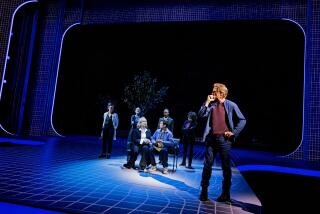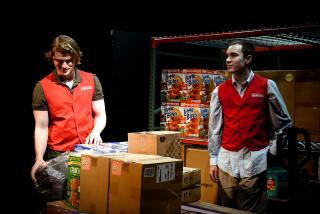How Bryan Cranstonâs towering performance in âNetworkâ packs new potency into Paddy Chayefskyâs 1976 tale of media mind control
Reporting from New York â Two thoughts occurred to me at the end of Ivo van Hoveâs stage production of âNetworkâ: Bryan Cranston is one of the most fearless actors working today, and Paddy Chayefsky attained a kind of prophecy when he wrote the screenplay for the 1976 Sidney Lumet film that saw straight through its own media age into ours.
Weâve all known how good Cranston is from his work on âBreaking Bad,â the cable drama that set a standard this new proliferous streaming era has had difficulty matching. Ballyhooed as he was for his performance as Walter White, the terminally ill chemistry teacher turned meth dealer, Cranston could have counted his Emmys and played it safe. Instead, he took to the stage in a tour de force of ferocious politicking as Lyndon B. Johnson in Robert Schenkkanâs âAll the Way.â
While a lesser actor may have been content to return to Hollywood twirling his Tony Award, Cranston found time amid his many film projects to take an even bolder theatrical risk. He decamped to London to join Van Hove, perhaps the most in-demand European theater auteur working today, on a stage version of âNetwork,â adapted by Lee Hall (âWar Horse,â âBilly Elliotâ) at the National Theatre.
The kind of acting Van Hove demands from his cast members is far removed from anything found in movies or television. Although his productions can devastate with their emotional precision, the performances are theatrically heightened and physically intrepid. Actors must feel free with their entire bodies, for they are unleashed onto the stage as though shot through a cannon.
Cranston already proved in âAll the Wayâ that he was capable of more than realism from the neck up. He attacked the part of LBJ the way LBJ attacked the problem of obtaining votes for congressional passage of the Civil Rights Act of 1964: wheedling, threatening, sweet-talking and collaring â all in thunderous theatrical motion.
âNetworkâ begins with Cranstonâs character, veteran news anchor Howard Beale, about to deliver the nightly news. A swirl of frenzied preparation leads to his on-camera greeting: âGood evening. It is Friday, September the 19th 1975, and I am Howard Beale. Today reaction to the capture of Patty Hearst â â
The production mediates the theatrical experience through screens: Cameras rotate and close-ups divert us from the performers to the transmitted images. A war, in effect, is being waged at the Belasco Theatre between theater and technology. Even those audience members who have shelled out big dollars to experience the show from the stage while enjoying a meal at one of the cafĂŠ tables or sipping a drink at the makeshift bar must rely on screens to navigate their way through the drama.
Proximity doesnât buy a privileged vantage in a production that deconstructs the viewing experience. The discrepancy between what happens on stage and its presentation on screen forces us to question the nature of reality itself when so much of collective life is being processed by forces that care more about numbers (i.e., money) than truth.
Howard is told after the evening broadcast that his numbers just arenât cutting it anymore and that his days as an anchor are coming to a close. He threatens to kill himself on the air to his old buddy Max (an elegantly game Tony Goldwyn), who runs the news division at the network. But all Max can offer his friend is ironic comfort: âYouâll get a hell of a rating, Iâll tell you that. A 50 share. Easy.â
Howard takes Max seriously. When he announces to his viewers during his next broadcast that he will soon be replaced, he finds a way to ensure that his audience will grow: He promises to kill himself on the air next Tuesday. (The advance notice, he later explains to his producers, will give them more time to promote the show.)
Our lives have been hijacked by corporate overlords who brainwashed us into confusing our real lives with what appears on our screens.
Everyone in the news division is up in arms at Howardâs crazy antics, but Diana Christensen (Tatiana Maslany), the head of programming charged with taking over the news, recognizes a gold mine when she sees one. The media becomes fixated on Howard, whose audience rapidly expands as he departs from the scripted news to deliver commentary that for Diana can be easily packaged as a âlatter-day prophet, a magnificent messianic figure, inveighing against the hypocrites of our time.â
Peter Finch, who was awarded a posthumous Oscar for playing Howard in the film, left an indelible impression as the unraveling news anchor commanding his viewers to open their windows and shout, âIâm mad as hell and Iâm not going to take this anymore.â Cranston wisely doesnât try to duplicate this masterly cinematic performance.
Instead, he approaches the role from a uniquely theatrical standpoint. The story of Howard Beale is grippingly conveyed through the manner of the characterâs stage presentation.
At the start, Cranstonâs Howard has the tight-jawed speech pattern of a newscaster determined to convey gravitas. Cranston could easily have given us his best Walter Cronkite, but the exaggerated artificiality of his delivery is a crucial note in a performance that flays all the fakery from the character until by the end Howard is talking directly to us in utter despair over how our lives have been hijacked by corporate overlords who brainwashed us into confusing our real lives with what appears on our screens.
Tottering in a raincoat as his mind unspools and his ratings explode, Cranstonâs Howard has the look of tortured bafflement of a New York King Lear â and indeed the performance raises the hope that one day Cranston will attempt this mightiest of Shakespearean roles.
The power of Cranstonâs portrayal seems fueled by the urgency of Chayefskyâs message. Television may have lost its cultural monopoly, but Silicon Valley has swooped in to extend the mind control by enslaving us to our devices.
I was stunned to see how many of the most resonant lines in the adaption come directly from the film. The medium changes, but the manipulation stays the same.
I had assumed that Hall must have updated the script to reflect on the new âmultinational dominion of dollars,â in which âall men will work to serve a common profit.â (These ideas, about the never-ending competition with Russian and Arab oligarchical interests, are fed to Howard by network chief Arthur Jensen, whoâs played here by Nick Wyman with the voice and demeanor of a hallucinated Zeus.) But after referring back to the screenplay I was stunned to see how many of the most resonant lines in the adaption come directly from the film. The medium changes but the manipulation stays the same.
The scenic and lighting design by the directorâs partner, Jan Versweyveld, turns the stage into a television set with a (metaphorically apt) glassed-in control booth. Tal Yardenâs video design grounds us in the tumultuous, recessionary 1970s, but the kaleidoscope of corrupt politicians, commercial advertising and terrorist fury permits us the double reality of believing that the story is taking place now.
The production falls short of Van Hove at his best. Some of the directorial flourishes seem derivative of his earlier work. This is the Belgian-born, Amsterdam-based auteurâs third production on Broadway (he won a 2016 Tony for his direction of âA View From the Bridge,â which came to the Ahmanson Theatre). Itâs thrilling to encounter his aesthetic on such grand stages, but the commercial pressures are having a subtle yet noticeable effect.
The company hasnât yet completely jelled. Unlike the ensemble members at the Toneelgroep Amsterdam (now the Internationaal Theater Amsterdam), where Van Hove is artistic director, the actors are thrown together. The intensity of some of the performers is off by a few degrees. Not everyone seems to have the same conviction in the ratcheted-up theatrical style.
Where this matters most â in Maslanyâs portrayal of Diana â may well be unavoidable. The simple fact is that Faye Dunaway already delivered an unbeatable Van Hovian performance in her Oscar-winning portrayal of a character who is the personification of the television industry itself. Maslany, the acclaimed star of the series âOrphan Black,â brings a robust naturalism but lacks the toppling neurotic ambition that drives Diana to program the unthinkable.
I kept fantasizing about a stage production of âNetworkâ that could combine Cranstonâs blistering performance today with Dunawayâs vertiginous performance of yesterday. Such a pairing would have given even Howard Bealeâs apocalypse act a run for its ratings money.
But Cranston communicates at towering strength everything that must have compelled Van Hove and Hall to brings Chayefskyâs screenplay to the stage. Itâs one of two unmissable performances by a lead actor this season on Broadway â the other being Jeff Daniels as Atticus Finch in Aaron Sorkinâs adaptation of âTo Kill a Mockingbird.â Broadwayâs award season hasnât even begun and already Iâm wondering how they might find a way to share the Tony Award spoils this spring.
MORE THEATER:
Best theater 2018: Our criticâs list
Taylor Macâs âHoliday Sauce,â a madcap brew, extra spicy
How much Cher is too much Cher? A Broadway musical answers
Follow me @charlesmcnulty
More to Read
The biggest entertainment stories
Get our big stories about Hollywood, film, television, music, arts, culture and more right in your inbox as soon as they publish.
You may occasionally receive promotional content from the Los Angeles Times.











